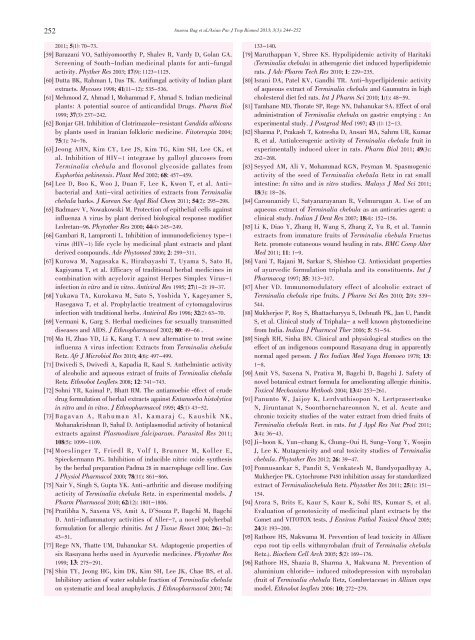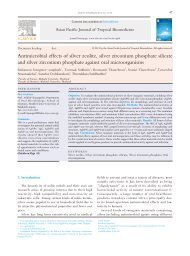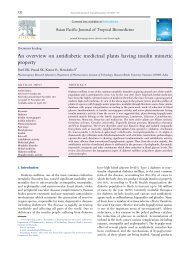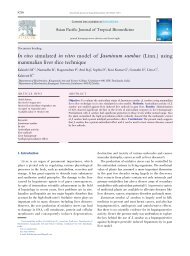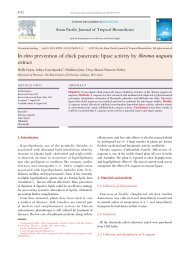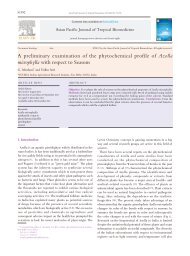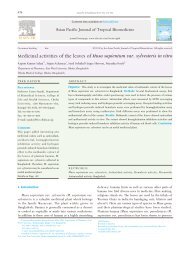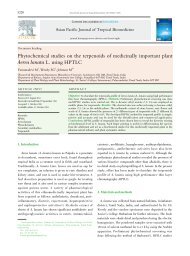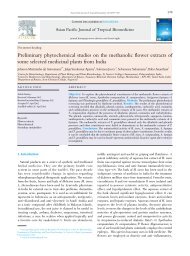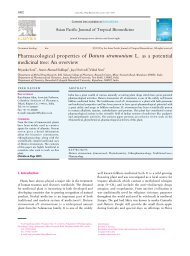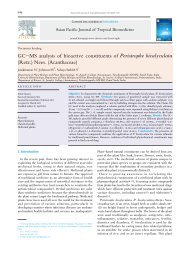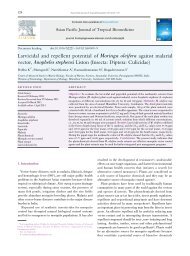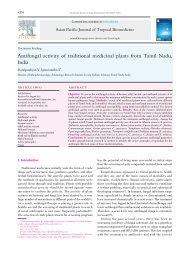Therapeutic potential of Terminalia chebula Retz ... - Apjtb.com
Therapeutic potential of Terminalia chebula Retz ... - Apjtb.com
Therapeutic potential of Terminalia chebula Retz ... - Apjtb.com
You also want an ePaper? Increase the reach of your titles
YUMPU automatically turns print PDFs into web optimized ePapers that Google loves.
252<br />
2011; 5(1): 70-73.<br />
[59] Barazani VO, Sathiyomoorthy P, Shalev R, Vardy D, Golan GA.<br />
Screening <strong>of</strong> South-Indian medicinal plants for anti-fungal<br />
activity. Phyther Res 2003; 17(9): 1123-1125.<br />
[60] Dutta BK, Rahman I, Das TK. Antifungal activity <strong>of</strong> Indian plant<br />
extracts. Mycoses 1998; 41(11-12): 535-536.<br />
[61] Mehmood Z, Ahmad I, Mohammad F, Ahmad S. Indian medicinal<br />
plants: A <strong>potential</strong> source <strong>of</strong> anticandidal Drugs. Pharm Biol<br />
1999; 37(3): 237-242.<br />
[62] Bonjar GH. Inhibition <strong>of</strong> Clotrimazole-resistant Candida albicans<br />
by plants used in Iranian folkloric medicine. Fitoterapia 2004;<br />
75(1): 74-76.<br />
[63] Jeong AHN, Kim CY, Lee JS, Kim TG, Kim SH, Lee CK, et<br />
al. Inhibition <strong>of</strong> HIV-1 integrase by galloyl glucoses from<br />
<strong>Terminalia</strong> <strong>chebula</strong> and flovonol glycoside gallates from<br />
Euphorbia pekinensis. Plant Med 2002; 68: 457-459.<br />
[64] Lee D, Boo K, Woo J, Duan F, Lee K, Kwon T, et al. Anti-<br />
bacterial and Anti-viral activities <strong>of</strong> extracts from <strong>Terminalia</strong><br />
<strong>chebula</strong> barks. J Korean Soc Appl Biol Chem 2011; 54(2): 295-298.<br />
[65] Badmaev V, Nowakowski M. Protection <strong>of</strong> epithelial cells against<br />
influenza A virus by plant derived biological response modifier<br />
Ledretan-96. Phytother Res 2000; 44(4): 245-249.<br />
[66] Gambari R, Lampronti L. Inhibition <strong>of</strong> immunodeficiency type-1<br />
virus (HIV-1) life cycle by medicinal plant extracts and plant<br />
derived <strong>com</strong>pounds. Adv Phytomed 2006; 2: 299-311.<br />
[67] Kurowa M, Nagasaka K, Hirabayashi T, Uyama S, Sato H,<br />
Kagiyama T, et al. Efficacy <strong>of</strong> traditional herbal medicines in<br />
<strong>com</strong>bination with acyclovir against Herpes Simplex Virus-1<br />
infection in vitro and in vitvo. Antiviral Res 1995; 27(1-2): 19-37.<br />
[68] Yukawa TA, Kurokawa M, Sato S, Yoshida Y, Kageyamer S,<br />
Hasegawa T, et al. Prophylactic treatment <strong>of</strong> cytomagalovirus<br />
infection with traditional herbs. Antiviral Res 1996; 32(2): 63-70.<br />
[69] Vermani K, Garg S. Herbal medicines for sexually transmitted<br />
diseases and AIDS. J Ethnopharmacol 2002; 80: 49-66 .<br />
[70] Ma H, Zhao YD, Li K, Kang T. A new alternative to treat swine<br />
influenza A virus infection: Extracts from <strong>Terminalia</strong> <strong>chebula</strong><br />
<strong>Retz</strong>. Afr J Microbiol Res 2010; 4(6): 497-499.<br />
[71] Dwivedi S, Dwivedi A, Kapadia R, Kaul S. Anthelmintic activity<br />
<strong>of</strong> alcoholic and aqueous extract <strong>of</strong> fruits <strong>of</strong> <strong>Terminalia</strong> <strong>chebula</strong><br />
<strong>Retz</strong>. Ethnobot Leaflets 2008; 12: 741-743.<br />
[72] Sohni YR, Kaimal P, Bhatt RM. The antiamoebic effect <strong>of</strong> crude<br />
drug formulation <strong>of</strong> herbal extracts against Entamoeba histolytica<br />
in vitro and in vitvo. J Ethnopharmacol 1995; 45(1): 43-52.<br />
[73] Bagavan A, Rahuman Al, Kamaraj C, Kaushik N K,<br />
Mohanakrishnan D, Sahal D. Antiplasmodial activity <strong>of</strong> botanical<br />
extracts against Plasmodium falciparum. Parasitol Res 2011;<br />
108(5): 1099-1109.<br />
[74] Moeslinger T, Friedl R, Volf I, Brunner M, Koller E,<br />
Spieckermann PG. Inhibition <strong>of</strong> inducible nitric oxide synthesis<br />
by the herbal preparation Padma 28 in macrophage cell line. Can<br />
J Physiol Pharmacol 2000; 78(11): 861-866.<br />
[75] Nair V, Singh S, Gupta YK. Anti-arthritic and disease modifying<br />
activity <strong>of</strong> <strong>Terminalia</strong> <strong>chebula</strong> <strong>Retz</strong>. in experimental models. J<br />
Pharm Pharmacol 2010; 62(12): 1801-1806.<br />
[76] Pratibha N, Saxena VS, Amit A, D’Souza P, Bagchi M, Bagchi<br />
D. Anti-inflammatory activities <strong>of</strong> Aller-7, a novel polyherbal<br />
formulation for allergic rhinitis. Int J Tissue React 2004; 26(1-2):<br />
43-51.<br />
[77] Rege NN, Thatte UM, Dahanukar SA. Adaptogenic properties <strong>of</strong><br />
six Rasayana herbs used in Ayurvedic medicines. Phytother Res<br />
1999; 13: 275-291.<br />
[78] Shin TY, Jeong HG, kim DK, Kim SH, Lee JK, Chae BS, et al.<br />
Inhibitory action <strong>of</strong> water soluble fraction <strong>of</strong> <strong>Terminalia</strong> <strong>chebula</strong><br />
on systematic and local anaphylaxis. J Ethnopharmacol 2001; 74:<br />
Anwesa Bag et al./Asian Pac J Trop Biomed 2013; 3(3): 244-252<br />
133-140.<br />
[79] Maruthappan V, Shree KS. Hypolipidemic activity <strong>of</strong> Haritaki<br />
(<strong>Terminalia</strong> <strong>chebula</strong>) in atherogenic diet induced hyperlipidemic<br />
rats. J Adv Pharm Tech Res 2010; 1: 229-235.<br />
[80] Israni DA, Patel KV, Gandhi TR. Anti-hyperlipidemic activity<br />
<strong>of</strong> aqueous extract <strong>of</strong> <strong>Terminalia</strong> <strong>chebula</strong> and Gaumutra in high<br />
cholesterol diet fed rats. Int J Pharm Sci 2010; 1(1): 48-59.<br />
[81] Tamhane MD, Thorate SP, Rege NN, Dahanukar SA. Effect <strong>of</strong> oral<br />
administration <strong>of</strong> <strong>Terminalia</strong> <strong>chebula</strong> on gastric emptying : An<br />
experimental study. J Postgrad Med 1997; 43 (1): 12-13.<br />
[82] Sharma P, Prakash T, Kotresha D, Ansari MA, Sahrm UR, Kumar<br />
B, et al. Antiulcerogenic activity <strong>of</strong> <strong>Terminalia</strong> <strong>chebula</strong> fruit in<br />
experimentally induced ulcer in rats. Pharm Biol 2011; 49(3):<br />
262-268.<br />
[83] Seyyed AM, Ali V, Mohammad KGN, Peyman M. Spasmogenic<br />
activity <strong>of</strong> the seed <strong>of</strong> <strong>Terminalia</strong> <strong>chebula</strong> <strong>Retz</strong> in rat small<br />
intestine: In vitvo and in vitro studies. Malays J Med Sci 2011;<br />
18(3): 18-26.<br />
[84] Carounanidy U, Satyanarayanan R, Velmurugan A. Use <strong>of</strong> an<br />
aqueous extract <strong>of</strong> <strong>Terminalia</strong> <strong>chebula</strong> as an anticaries agent: a<br />
clinical study. Indian J Dent Res 2007; 18(4): 152-156.<br />
[85] Li K, Diao Y, Zhang H, Wang S, Zhang Z, Yu B, et al. Tannin<br />
extracts from immature fruits <strong>of</strong> <strong>Terminalia</strong> <strong>chebula</strong> Fructus<br />
<strong>Retz</strong>. promote cutaneous wound healing in rats. BMC Comp Alter<br />
Med 2011; 11: 1-9.<br />
[86] Vani T, Rajani M, Sarkar S, Shishoo CJ. Antioxidant properties<br />
<strong>of</strong> ayurvedic formulation triphala and its constituents. Int J<br />
Pharmacog 1997; 35: 313-317.<br />
[87] Aher VD. Immunomodulatory effect <strong>of</strong> alcoholic extract <strong>of</strong><br />
<strong>Terminalia</strong> <strong>chebula</strong> ripe fruits. J Pharm Sci Res 2010; 2(9): 539-<br />
544.<br />
[88] Mukherjee P, Roy S, Bhattacharyya S, Debnath PK, Jan U, Pandit<br />
S, et al. Clinical study <strong>of</strong> Triphala- a well known phytomedicine<br />
from India. Indian J Pharmcol Ther 2006; 5: 51-54.<br />
[89] Singh RH, Sinha BN. Clinical and physiological studies on the<br />
effect <strong>of</strong> an indigenous <strong>com</strong>pound Rasayana drug in apparently<br />
normal aged person. J Res Indian Med Yoga Homoeo 1978; 13:<br />
1-8.<br />
[90] Amit VS, Saxena N, Prativa M, Bagchi D, Bagchi J. Safety <strong>of</strong><br />
novel botanical extract formula for ameliorating allergic rhinitis.<br />
Toxicol Mechanisms Methods 2004; 13(4): 253-261.<br />
[91] Panunto W, Jaijoy K, Lerdvuthisopon N, Lertprasertsuke<br />
N, Jiruntanat N, Soonthornchareonnon N, et al. Acute and<br />
chronic toxicity studies <strong>of</strong> the water extract from dried fruits <strong>of</strong><br />
<strong>Terminalia</strong> <strong>chebula</strong> Rezt. in rats. Int J Appl Res Nat Prod 2011;<br />
3(4): 36-43.<br />
[92] Ji-hoon K, Yun-chang K, Chung-Oui H, Sung-Yong Y, Woojin<br />
J, Lee K. Mutagenicity and oral toxicity studies <strong>of</strong> <strong>Terminalia</strong><br />
<strong>chebula</strong>. Phytother Res 2012; 26: 39-47.<br />
[93] Ponnusankar S, Pandit S, Venkatesh M, Bandyopadhyay A,<br />
Mukherjee PK. Cytochrome P450 inhibition assay for standardized<br />
extract <strong>of</strong> <strong>Terminalia</strong><strong>chebula</strong> <strong>Retz</strong>. Phytother Res 2011; 25(1): 151-<br />
154.<br />
[94] Arora S, Brits E, Kaur S, Kaur K, Sohi RS, Kumar S, et al.<br />
Evaluation <strong>of</strong> genotoxicity <strong>of</strong> medicinal plant extracts by the<br />
Comet and VITOTOX tests. J Environ Pathol Toxicol Oncol 2005;<br />
24(3): 193-200.<br />
[95] Rathore HS, Makwama M. Prevention <strong>of</strong> lead toxicity in Allium<br />
cepa root tip cells withmyrobalan (fruit <strong>of</strong> <strong>Terminalia</strong> <strong>chebula</strong><br />
<strong>Retz</strong>.). Biochem Cell Arch 2005; 5(2): 169-176.<br />
[96] Rathore HS, Shazia B, Sharma A, Makwana M. Prevention <strong>of</strong><br />
aluminium chloride- induced mitodepression with myrobalan<br />
(fruit <strong>of</strong> <strong>Terminalia</strong> <strong>chebula</strong> <strong>Retz</strong>, Combretaceae) in Allium cepa<br />
model. Ethnobot leaflets 2006: 10; 272-279.


